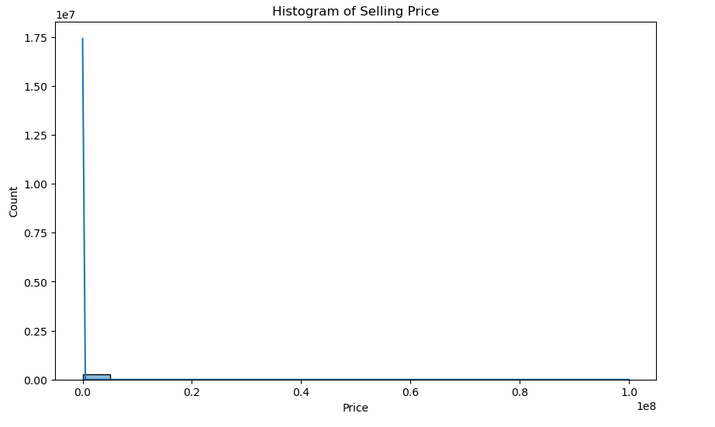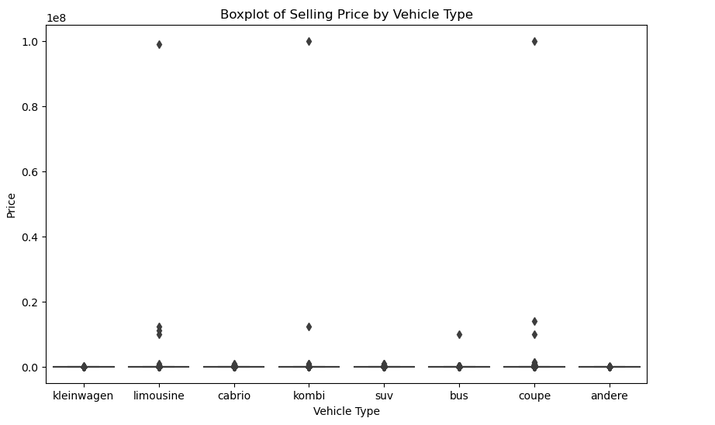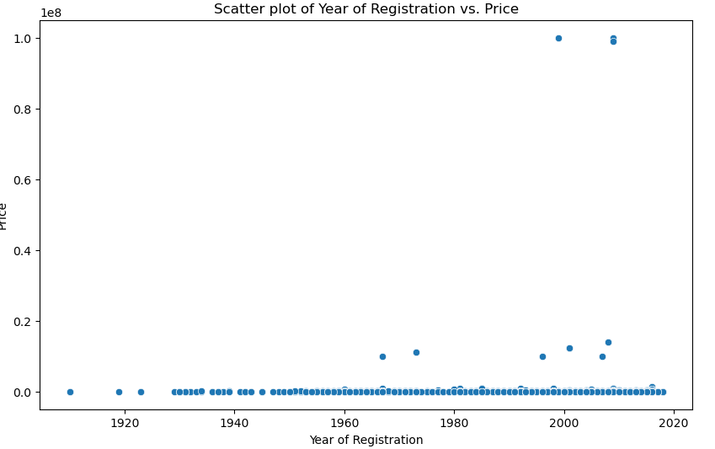
 Data Structure
Data Structure Networking
Networking RDBMS
RDBMS Operating System
Operating System Java
Java MS Excel
MS Excel iOS
iOS HTML
HTML CSS
CSS Android
Android Python
Python C Programming
C Programming C++
C++ C#
C# MongoDB
MongoDB MySQL
MySQL Javascript
Javascript PHP
PHP
- Selected Reading
- UPSC IAS Exams Notes
- Developer's Best Practices
- Questions and Answers
- Effective Resume Writing
- HR Interview Questions
- Computer Glossary
- Who is Who
Analyzing selling price of used cars using Python
Analyzing the selling price of used cars is crucial for both buyers and sellers to make informed decisions which can easily be done using Python. By leveraging Python's data analysis and visualization capabilities, valuable insights can be gained from the available dataset.
This article explores the process of data preprocessing, cleaning, and analyzing the selling price using various plots. Additionally, it covers predicting the selling price using a Linear Regression model. With Python's powerful libraries such as pandas, matplotlib, seaborn, and scikit-learn, this analysis provides a comprehensive approach to understanding the factors influencing used car prices and making accurate price predictions.
How to analyze the selling price of used cars using Python?
Follow the steps given below to analyze the selling price of used cars using Python ?
Step 1: Import the important libraries
import pandas as pd import matplotlib.pyplot as plt import seaborn as sns from sklearn.model_selection import train_test_split from sklearn.linear_model import LinearRegression from sklearn.metrics import mean_squared_error
Step 2:Read the dataset and store it in pandas dataframe
data = pd.read_csv('C:/Users/Tutorialspoint/Documents/autos.csv', encoding='latin1')
Step 3: Check the structure of the dataset
data.info() print(data.head())
Output
dateCrawled seller offerType price vehicleType \
3 2016-03-17 16:54:04 privat Angebot 1500 kleinwagen
4 2016-03-31 17:25:20 privat Angebot 3600 kleinwagen
5 2016-04-04 17:36:23 privat Angebot 650 limousine
6 2016-04-01 20:48:51 privat Angebot 2200 cabrio
7 2016-03-21 18:54:38 privat Angebot 0 limousine
yearOfRegistration gearbox powerPS model kilometer \
3 2001 manuell 75 golf 150000
4 2008 manuell 69 fabia 90000
5 1995 manuell 102 3er 150000
6 2004 manuell 109 2_reihe 150000
7 1980 manuell 50 andere 40000
monthOfRegistration fuelType brand notRepairedDamage dateCreated \
3 6 benzin volkswagen nein 2016-03-17
4 7 diesel skoda nein 2016-03-31
5 10 benzin bmw ja 2016-04-04
6 8 benzin peugeot nein 2016-04-01
7 7 benzin volkswagen nein 2016-03-21
lastSeen
3 2016-03-17 17:40:17
4 2016-04-06 10:17:21
5 2016-04-06 19:17:07
6 2016-04-05 18:18:39
7 2016-03-25 16:47:58
Step 4: Handling missing values
data = data.dropna()
Step 5: Convert the datatypes only if necessary
data['dateCrawled'] = pd.to_datetime(data['dateCrawled']) data['dateCreated'] = pd.to_datetime(data['dateCreated'])
Step 6: Data Cleaning
# Remove irrelevant columns columns_to_drop = ['name', 'abtest', 'nrOfPictures', 'postalCode'] data = data.drop(columns=columns_to_drop)
Step 7: Analyzing Selling Price Using Plots
Example 1: Histogram of Selling Price
plt.figure(figsize=(10, 6))
sns.histplot(data['price'], bins=20, kde=True)
plt.xlabel('Price')
plt.ylabel('Count')
plt.title('Histogram of Selling Price')
plt.show()
Output

Example 2: Boxplot of Selling Price by Vehicle Type
plt.figure(figsize=(10, 6))
sns.boxplot(x='vehicleType', y='price', data=data)
plt.xlabel('Vehicle Type')
plt.ylabel('Price')
plt.title('Boxplot of Selling Price by Vehicle Type')
plt.show()
Output

Example 3: Scatter plot of Year of Registration vs. Price
plt.figure(figsize=(10, 6))
sns.scatterplot(x='yearOfRegistration', y='price', data=data)
plt.xlabel('Year of Registration')
plt.ylabel('Price')
plt.title('Scatter plot of Year of Registration vs. Price')
plt.show()
Output

Step 8: Predicting Selling Price using Linear Regression
Select relevant features and target variable
features = ['yearOfRegistration', 'powerPS', 'kilometer'] target = 'price' X = data[features] y = data[target]
Split the data into training and testing sets:
X_train, X_test, y_train, y_test = train_test_split(X, y, test_size=0.2, random_state=42)
Initialize and train the Linear Regression model
model = LinearRegression() model.fit(X_train, y_train)
Output
LinearRegression
Step 9: Make predictions on the test set and print the predicted selling price
# Make predictions on the test set
y_pred = model.predict(X_test)
# Print the predicted selling price
print("Predicted Selling Price:")
for price in y_pred:
print(price)
Output
Predicted Selling Price: 4697.820983235375 4882.88628493459 2407.3556394173065 4264.297985512414 5801.285403149028 6486.864555639331 18844.05037380848 3615.3753698624205 15154.480417441286 7511.02954521589 5815.107292202709 14360.747495675983 3868.0368050450925 6433.695591624826 3019.621718226932 ?????????????? 3723.5291391374194
Step 10: Evaluate the model using Mean Squared Error (MSE)
mse = mean_squared_error(y_test, y_pred)
print(f"Mean Squared Error: {mse}")
Output
Mean Squared Error: 3838157266.6337757
Conclusion
In conclusion, Python's versatility and powerful libraries make it an ideal tool for analyzing the selling price of used cars. Through data preprocessing, cleaning, and visualization, valuable insights can be obtained. Furthermore, predictive modeling with machine learning algorithms enables accurate price predictions. This analysis empowers both buyers and sellers to make informed decisions in the used car market.

